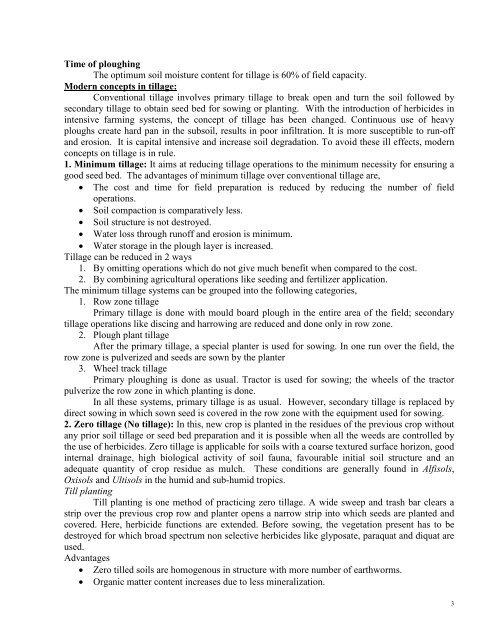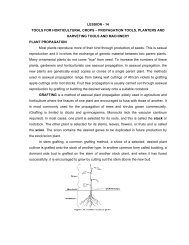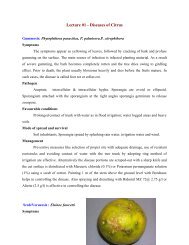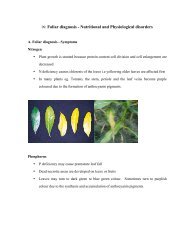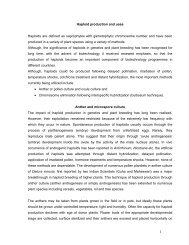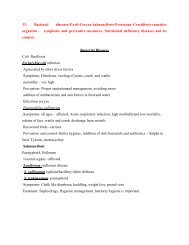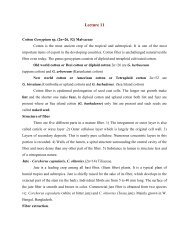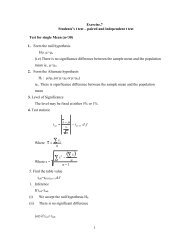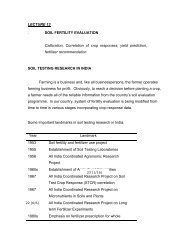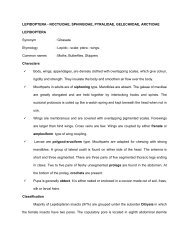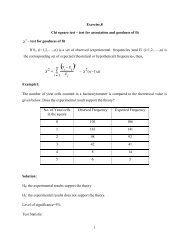Tillage – Definition – objectives – types of tillage - modern ... - TNAU
Tillage – Definition – objectives – types of tillage - modern ... - TNAU
Tillage – Definition – objectives – types of tillage - modern ... - TNAU
You also want an ePaper? Increase the reach of your titles
YUMPU automatically turns print PDFs into web optimized ePapers that Google loves.
Time <strong>of</strong> ploughingThe optimum soil moisture content for <strong>tillage</strong> is 60% <strong>of</strong> field capacity.Modern concepts in <strong>tillage</strong>:Conventional <strong>tillage</strong> involves primary <strong>tillage</strong> to break open and turn the soil followed bysecondary <strong>tillage</strong> to obtain seed bed for sowing or planting. With the introduction <strong>of</strong> herbicides inintensive farming systems, the concept <strong>of</strong> <strong>tillage</strong> has been changed. Continuous use <strong>of</strong> heavyploughs create hard pan in the subsoil, results in poor infiltration. It is more susceptible to run-<strong>of</strong>fand erosion. It is capital intensive and increase soil degradation. To avoid these ill effects, <strong>modern</strong>concepts on <strong>tillage</strong> is in rule.1. Minimum <strong>tillage</strong>: It aims at reducing <strong>tillage</strong> operations to the minimum necessity for ensuring agood seed bed. The advantages <strong>of</strong> minimum <strong>tillage</strong> over conventional <strong>tillage</strong> are,• The cost and time for field preparation is reduced by reducing the number <strong>of</strong> fieldoperations.• Soil compaction is comparatively less.• Soil structure is not destroyed.• Water loss through run<strong>of</strong>f and erosion is minimum.• Water storage in the plough layer is increased.<strong>Tillage</strong> can be reduced in 2 ways1. By omitting operations which do not give much benefit when compared to the cost.2. By combining agricultural operations like seeding and fertilizer application.The minimum <strong>tillage</strong> systems can be grouped into the following categories,1. Row zone <strong>tillage</strong>Primary <strong>tillage</strong> is done with mould board plough in the entire area <strong>of</strong> the field; secondary<strong>tillage</strong> operations like discing and harrowing are reduced and done only in row zone.2. Plough plant <strong>tillage</strong>After the primary <strong>tillage</strong>, a special planter is used for sowing. In one run over the field, therow zone is pulverized and seeds are sown by the planter3. Wheel track <strong>tillage</strong>Primary ploughing is done as usual. Tractor is used for sowing; the wheels <strong>of</strong> the tractorpulverize the row zone in which planting is done.In all these systems, primary <strong>tillage</strong> is as usual. However, secondary <strong>tillage</strong> is replaced bydirect sowing in which sown seed is covered in the row zone with the equipment used for sowing.2. Zero <strong>tillage</strong> (No <strong>tillage</strong>): In this, new crop is planted in the residues <strong>of</strong> the previous crop withoutany prior soil <strong>tillage</strong> or seed bed preparation and it is possible when all the weeds are controlled bythe use <strong>of</strong> herbicides. Zero <strong>tillage</strong> is applicable for soils with a coarse textured surface horizon, goodinternal drainage, high biological activity <strong>of</strong> soil fauna, favourable initial soil structure and anadequate quantity <strong>of</strong> crop residue as mulch. These conditions are generally found in Alfisols,Oxisols and Ultisols in the humid and sub-humid tropics.Till plantingTill planting is one method <strong>of</strong> practicing zero <strong>tillage</strong>. A wide sweep and trash bar clears astrip over the previous crop row and planter opens a narrow strip into which seeds are planted andcovered. Here, herbicide functions are extended. Before sowing, the vegetation present has to bedestroyed for which broad spectrum non selective herbicides like glyposate, paraquat and diquat areused.Advantages• Zero tilled soils are homogenous in structure with more number <strong>of</strong> earthworms.• Organic matter content increases due to less mineralization.3


